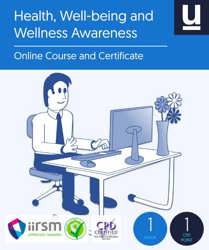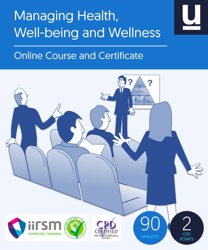What is ISO 45003 and what does it cover?
Everyone at work is at risk of experiencing a psychosocial hazard. These risks include the structure of work, social factors, work environment, and hazardous tasks.
ISO 45003 is the first global standard that brings attention to how a work environment and the nature of the job can impact employee mental health. It gives employers practical advice and a plan for finding and dealing with the psychosocial risks their employees may face.
The ISO made the 45003 guidance to complement with ISO 45001, a standard for putting together a health and safety management system at work. But it also has a lot of helpful information and advice for companies that still need to adopt ISO 45001.
If you want more information on its impact, check out our Health, Wellbeing and Wellness Awareness course on our website.
Why is complying with ISO 45003 beneficial?
Failing to promote mental wellbeing can impact staff members' physical health. Work-related stress can lead to cardiovascular disease, anxiety, depression, and sleep disorders. It can also encourage poor health behaviours like substance misuse or unhealthy eating.
Employers can help staff avoid these conditions by following ISO 45003 and promoting positive mental health at work. Applying the guidelines can improve job satisfaction and productivity.
Following ISO 45003 is not required by law. But the Health and Safety Executive (HSE) considers mental health problems a health and safety risk—the Health and Safety at Work etc. Act of 1974 says that employers must protect their workers from this risk (HSWA).
By following ISO 45003, an employer can be sure they are doing everything they can to care for their workers' physical and mental health.
How can an organisation manage and identify psychosocial risks within the workplace?
To deal with psychosocial risks in the workplace, a company should make a risk assessment and an effective action plan. It should consider its employees' external and internal problems and determine how to structure work to improve their health.
- Internal issues involve how the organisation operates, how people work, what resources are available, and where people work.
- External issues are outside of the organisation's control. For example, customer demands or changes in the economy affecting the amount of work available.
When planning to help workers' mental health, an organisation should consider what its workers want and need.
These may include:
- Information and support.
- Financial security.
- Social interaction and support.
- Recognition and reward for their efforts.
- Personal development and growth.
- Equal treatment and opportunities.
How can an organisation evaluate the existing controls?
When planning to deal with psychosocial risks, a company should figure out what risks its employees face. It should determine what could go wrong. Then it should assess what controls would eliminate these risks or make them less hazardous.
These controls are split into three different types by the ISO 45003 standard:
- Primary interventions
- Secondary interventions
- Tertiary interventions
Primary Interventions in the ISO45003
Primary interventions are those control measures that prevent or minimise psychosocial risks. These include:
- Reorganising tasks or work processes so that they pose less of a psychosocial risk. Consider making job roles more transparent, giving employees more breaks and freedom with their work. Offer extra support for help when their workload goes up.
- Helping workers who are having social problems at work. Such as those who lack supervision, do not have a good work/life balance, or anyone experiencing bullying or harassment.
- Giving employees the right tools to protect them from environmental dangers like low temperatures or loud noise.
Secondary Interventions in the ISO45003
Secondary interventions are measures designed to help workers to deal with psychosocial risks, such as:
- Raising awareness of psychosocial risks within the workplace.
- Providing staff with practical training on managing their mental health and wellbeing.
- Providing staff with regular access to medical professionals to discuss their psychosocial health.
Tertiary Interventions in the ISO45003
Tertiary interventions support those exposed to psychosocial hazards. To be effective, organisations must understand the signs of poor psychosocial health, such as:
- Social withdrawal.
- Reduced energy and motivation.
- Increased absence from work.
- Low performance.
- Missing deadlines.
- Reduced desire to work with others.
- Committing more errors than usual.
Organisations should create a rehabilitation plan to help employees who have faced mental stress at work. It should also work on fixing any underlying issues in the work environment.
Monitoring and evaluation of control measures
Once an organisation makes changes, it should monitor and review them when necessary. For example, a significant workplace change may present additional psychosocial hazards to manage.
Monitoring and reviewing these control measures can help prevent and manage psychosocial risks in the future.
At Commodious, we offer two training courses on health, wellbeing and wellness. These courses provide an overview of health and wellbeing and guide how to manage them within a workplace. Learn more about these courses below:




